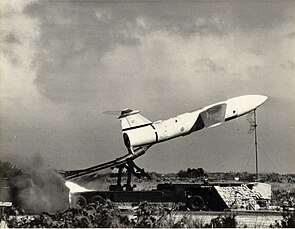MGM-1 Matador
| MGM-1 Matador | |
|---|---|
| General Information | |
| Type | Cruise missiles |
| Manufacturer | Glenn L. Martin Company |
| development | 1949 |
| Commissioning | 1954 |
| Technical specifications | |
| length | 12.10 m |
| diameter | 1,200 mm |
| Combat weight | 5,400 kg |
| span | 8,700 mm |
| Drive First stage Second stage |
Solid fuel booster Turbojet Allison J33-A-37 with 20 kN thrust |
| speed | Mach 0.9 |
| Range | 1,050 km |
| Furnishing | |
| Target location | INS plus radio command steering |
| Warhead | W5 nuclear warhead 40 kt |
| Weapon platforms | Bunkered position |
| Lists on the subject | |
The MGM-1 Matador was the first US military cruise missile . It was developed from 1949 and carried a nuclear warhead . The weapon was also stationed in the Federal Republic of Germany during the Cold War . The forerunner of the Matador as an independently flying cruise missile was the German design Fieseler Fi 103 (V1) from 1943.
Development and technology
The first launch of a Matador with the type designation XSSM-A-1 took place in January 1947 on the White Sands Missile Range , from 1951 the tests were continued at Patrick Air Force Base in Florida. In late 1953, the US military's first Matador battery was operational. It was equipped with W5 , which had a comparatively low explosive force of 40 kT TNT .
In 1951, the USAF introduced the model designation applicable to airplanes for guided missiles as well, since missiles were regarded as unmanned aircraft. The XSSM-A-1 and YSSM-A-1 were renamed XB-61 and YB-61. The standard version B-61A were slightly larger than the XB / YB-61 and had a structurally modified cell . In contrast to the previous middle-decker, a high-decker design has now been chosen. In 1955, the USAF changed its mind about aircraft classification and the B-61 was renamed the TM-61A as a tactical missile.
The missile was guided by radio remote control and tracked with a network of radar stations on the ground. The radio connection required a direct beeline, so the range was limited to 400 km. It was also endangered by possible enemy disruptive measures .
In 1954, therefore, the US Air Force began developing the YTM-61C version, which used the Shanicle (Short Range Navigation Vehicle) control system. It consisted of a number of ground-based microwave (radar) transmitters that generated a radio network for displaying distance and azimuth , on the basis of which the Matador navigated. This enabled the usable range to be extended to a maximum of 1,000 km.
The last Matador were decommissioned in 1962 after 1,200 units had been produced.
In addition to Japan and South Korea , the cruise missiles were also stationed in the Federal Republic of Germany: in Rhineland-Palatinate , bunkered silos were built near Idenheim and Rittersdorf , from which the missiles could have been launched under the leadership of the 701st (from 1958 the 38th) Tactical Missile Wing. There were identical systems on the Japanese island group of Okinawa .
Web links
- Directory of US Military Rockets and Missiles
- Bitburg AB - 585th Tactical Missile Group Matador in Germany
- Launch system Rittersdorf - Site VII - 71st Tactical Missile Squadron
- Launch facility Idenheim - Site VIII - 71st Tactical Missile Squadron
Individual evidence
- ↑ Globalsecurity.org: Overview of missile weapons (engl.) (Consulted on October 7, 2019)
- ↑ Description on www.designation-systems.net
